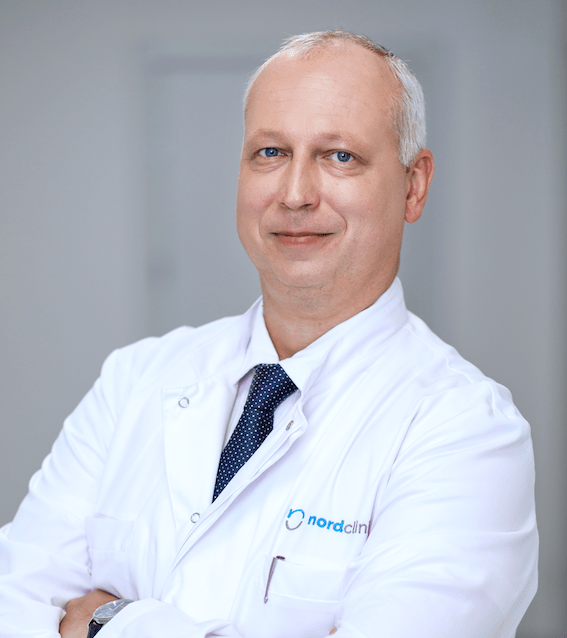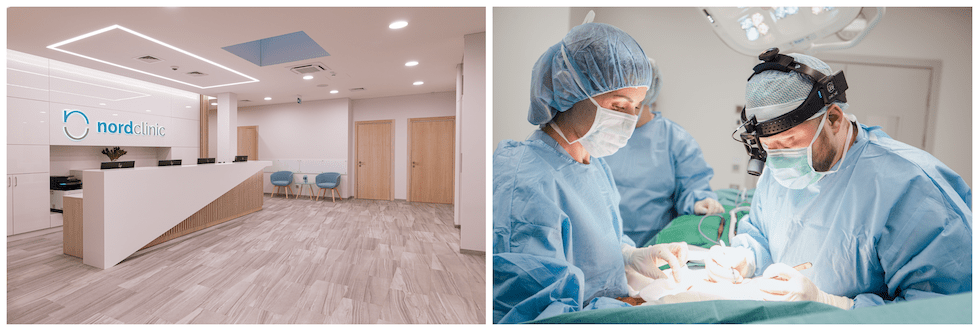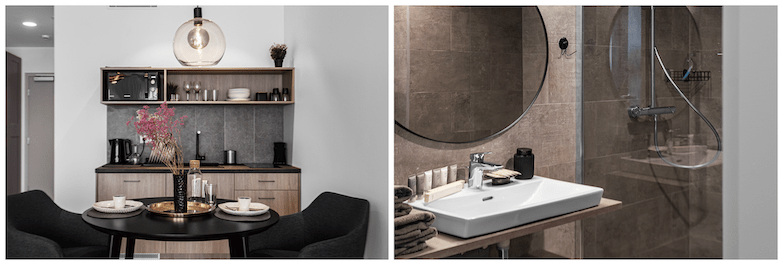Endoscopic abdominoplasty with repair of diastasis recti
Leading medical tourism clinic
We are the leading medical tourism clinic in the Baltic region with over 10 years of experience. We are proud of the fact that around 90% of our patients come from abroad: the UK, Ireland and Scandinavian countries – this is the area we specialise in and our processes have been adapted to cater specifically for patients from abroad. Our team of surgeons perform over 4.000 surgeries per year, mostly plastic, bariatric, orthopaedic, general and gynecological surgeries.
See before-after pictures
Facebook reviews & group
Prices
- endoscopic abdominoplasty with repair of diastasis recti – 2.000 £
- mini tummy tuck – 2.450 £
- tummy tuck – 3.100 £
- mommy makeover: breast lift, implants, tummy tuck – 6.125 £
- additional aftercare: hyperbaric oxygen therapy, aftercare package in the UK and Ireland, accommodation with medical care
- additional procedures: gynecological, dermatology (including FREE consultation)
- consultation with the surgeon
- necessary health tests
- surgery
- anaesthesia
- hospitalisation (1-2 nights) with free Wi-Fi and Netflix
- a massage to help you recover quickly
- 24/7 personal assistance during your stay
- transfers to / from the airport, hotel and clinic
Please note that the price of the surgery itself is provisional and may be accurately assessed only after the evaluation of each individual case.
The default currency in our clinic is Euro, so if you were looking at prices in GBP it may vary depending on GBP / EUR exchange rate at the moment of of payment.
Save money and time by combining your tummy tuck surgery with:
- Other plastic surgeries:
- Breast enlargement – from 3.050 £
- Breast lift – 3.050 £
- Breast enlargement & breast lift – 4.670 £
- Liposuction – from 580 £
- Gynecological procedures – from 1.000 £
5% of our patients choose to combine tummy tuck with intimate surgeries; - Hernia surgery – from 1.500 £
Combining multiple surgeries (depending on procedures combined) the discount can be as much as 10% in the total price.
The surgery combination volume is decided together with the surgeon in accordance with all safety measures. The surgery should not last longer than 6 hours.
All of our patients can use one of our offers available at the moment.
- Special 5-10% discount for booking in our last minute booking service for the next 30 days.
- Usually from 10% to 30% discount for combining multiple surgeries. Find more information in the “Combine to save” tab above.
- Additional services in our clinic. You or your accompanying persons can explore the various services by following this link. Customise your preferences and request to book any preferred procedures.
- Brand ambassador discount. If you have a community that would be interested in our services, you can now get a discount for your procedure by spreading the word about our clinic on your social media. Contact your customer service representative for more information.
Find more information about the available offers here.
- endoscopic abdominoplasty with repair of diastasis recti – 2.400 €
- mini tummy tuck – 2.900 €
- tummy tuck – 3.700 €
- mommy makeover: breast lift, implants, tummy tuck – 7.350 €
- additional aftercare: hyperbaric oxygen therapy, aftercare package in the UK and Ireland, accommodation with medical care
- additional procedures: gynecological, dermatology (including FREE consultation)
- consultation with the surgeon
- necessary health tests
- surgery
- anaesthesia
- hospitalisation (1-2 nights) with free Wi-Fi and Netflix
- a massage to help you recover quickly
- 24/7 personal assistance during your stay
- transfers to / from the airport, hotel and clinic
Please note that the price of the surgery itself is provisional and may be accurately assessed only after the evaluation of each individual case.
The default currency in our clinic is Euro, so if you were looking at prices in GBP it may vary depending on GBP / EUR exchange rate at the moment of of payment.
Save money and time by combining your tummy tuck surgery with:
- Other plastic surgeries:
- Breast enlargement – from 3.650 €
- Breast lift – 3.650 €
- Breast enlargement & breast lift – 5.600 €
- Liposuction – from 700 €
- Gynecological procedures – from 1.200 €
5% of our patients chnoroose to combine tummy tuck with intimate surgeries; - Hernia surgery – from 1.800 €
Combining multiple surgeries (depending on procedures combined) the discount can be as much as 10% in the total price.
The surgery combination volume is decided together with the surgeon in accordance with all safety measures. The surgery should not last longer than 6 hours.
All of our patients can use one of our offers available at the moment.
- Special 5-10% discount for booking in our last minute booking service for the next 30 days.
- Usually from 10% to 30% discount for combining multiple surgeries. Find more information in the “Combine to save” tab above.
- Additional services in our clinic. You or your accompanying persons can explore the various services by following this link. Customise your preferences and request to book any preferred procedures.
- Brand ambassador discount. If you have a community that would be interested in our services, you can now get a discount for your procedure by spreading the word about our clinic on your social media. Contact your customer service representative for more information.
Find more information about the available offers here.
- Informational meeting with plastic surgeons G.Astrauskaite in DUBLIN on September 7-8 and A. Dobilinskas in LONDON on September 21-22.
- Alternatively, slots for online consultations with plastic surgeons are available!
Book your spot >>
Aftercare
Videos about our clinic
Find more videos of patients, surgeons and the clinic here.
Our patients and clinic in the media
12 reasons that make us the most popular plastic surgery clinic abroad
Even 68% of our patients travel to have combined surgeries due to our expertise in this field – it has been our specialisation for many years now. We performed such surgeries for more than 10.000 patients to this date. Combining surgeries allow our patients to save time, money and even health. We carefully select patients, evaluate each case individually, and only agree to combine surgeries within health & safety limits.
We are one of the leading plastic surgery clinics in the European Union with over 10 years of experience. Our team of 12 plastic surgeons performs more than 3.000 plastic operations a year and around 90 % of our patients travel from abroad, mostly the UK, Ireland, Norway, Sweden, Denmark, Germany.
Already more than 30.000 of our former, current and future patients joined our online community with the aim to build a space for opinions and mutual support. Members are welcome to share experiences about their visit to the clinic and to discuss all surgery-related matters.
Our team of 12 plastic surgeons has 10-15 years of experience in the field in total performing over 3.000 different plastic surgeries per year. Moreover, our surgeons are members of various prestigious surgical societies both Lithuanian and international.
Our clinic or patients are seen on different media mentions like: BBC, Forbes, Mirror, MailOnline, The Sun and others.
Our clinic works according to the highest standards set by the European Union. This helps to guarantee the quality of medical services. We care about the safety, comfort and successful results of our patients from all over the world.
We provide customer service in 9 foreign languages including English, Swedish, Norwegian, Ukrainian, Italian, Spanish, French, Russian, Polish. Everyone in our clinic speaks English, including nurses, assistants and the surgeon.
Every patient has a dedicated customer service representative, helping patients plan their visit, answer all associated questions, available every working day via email/phone.
We do offer an exclusive Aftercare package in the UK and Ireland for our plastic surgery patients. With our Aftercare package, you will get extra support and help while healing and recovering back in the UK or Ireland. Our partner Hollie is a professional cosmetic nurse practitioner with 17 years of post-registration experience. Now Hollie is managing the nurse network in the UK and Ireland which is ready to help you, the patients of the Nordesthetics.
Patients have an opportunity to stay in the apartments, supervised by our clinic. Apartments are located in the centre of Kaunas and most importantly, right next to our new clinic, in the same building (1 min by foot) and are provided with additional medical care (the nurse visits a patient at least once a day after discharge from the clinic), which is not possible while staying in a hotel or other accommodation.
All inclusive price, which is twice lower than in Western European clinics. Our clinic works with medical professionals of the highest education and experience level and uses the same materials as the clinics in Western Europe. More often than not, the quality of our clinic‘s facilities exceed the ones in Western European clinics. The price difference is only due to considerably lower average salaries and taxes – which is the main reason for medical travel everywhere around the world.
Abdominal surgeon Linas Venclauskas

- Abdominal surgeon with over 15 years’ of experience
- Specialises in minimally invasive surgery, surgical treatment of the upper gastrointestinal tract and bariatric surgery
- Associate Professor at Lithuanian University of Health Sciences
- President of the Kaunas Society of Surgeons
- A member of the European Hernia Society
- Chairman of the Lithuanian Society of Hernia Surgery
Direct flights to Lithuania







Our clinic is the biggest plastic surgery center in Baltic states
Self-catered accommodation with medical care
What is abdominal muscle diastasis? How to identify it?
Abdominal muscle diastasis (diastasis “linea albae” or rectal abdominal muscle) is a condition referring to an abnormal separation of the abdominal wall muscles. One of the main core muscles is the rectus abdominis muscle, a so-called “six-pack”. The abdominal muscle is comprised of two parallel muscles that are separated in the middle by a strand of connective tissue. During pregnancy, the connective tissue stretches and the two sides of the muscles separate. For most women, the abdominal muscles return to their previous location right after pregnancy, but for others, the muscles stay separated, creating a saggy look of the lower belly.
The main complaint in patients with abdominal muscle separation is the poor shape of the abdomen and pain or discomfort in the abdominal area after physical activity. Patients notice a visible gap between the two muscles that are especially apparent when laying down, coughing, or laughing. Lower back pain and constipation are also common complaints due to low abdominal muscle strength.
Who is a good candidate for abdominal wall reconstruction?
To be considered for a surgical abdominal wall repair a patient should have a gap of at least 2 cm, measured 3 cm in the midline abdomen above the belly button. The best postoperative results can be reached when diastasis of abdominal muscle is under 5 cm.
Abdominal wall reconstruction is only considered for those patients who have attempted conservative treatment methods, mainly physical therapy exercises. Women should wait at least 1 year after giving birth before opting for surgical repair.
Abdominal wall reconstruction surgery may not be a good choice for those who desire to remove excess skin. In such cases, patients may get more satisfying results with surgeries, like a full tummy tuck or mommy makeover.
Some patients, like those with general health problems (blood clotting disorders, cirrhosis of the liver, or renal insufficiency), may not be eligible for the surgery.
How can abdominal muscle diastasis be repaired?
Abdominal wall separation can be repaired conservatively or with surgical repair. Non-surgical methods include weight loss and exercise to improve muscle strength. However, conservative methods have not been shown to provide encouraging results.
The most common treatment method that provides complete symptomatic relief is abdominal wall reconstruction surgery. Surgery restores the integrity of the abdominal wall so that it can protect the internal organs and provide good support for the spine. Abdominal muscle diastasis can be repaired in conjunction with other cosmetic surgeries, like a tummy tuck or a mommy makeover.
What is SCOLA method?
SCOLA (Subcutaneous Onlay Laparoscopic Approach) is a surgical abdominal wall repair technique that is shown to be a safe and effective approach to repair abdominal muscle diastasis or umbilical hernias. To perform SCOLA, a surgeon makes 3 small incisions above the pubic bone and then uses a laparoscope (a tiny camera) and other surgical instruments to reach the abdominal muscles underneath the skin. Usually to repair diastasis it is enough to use slowly absorbable sutures. Sometimes the special mesh could be placed on the rectal abdominal muscles if it is necessary (in case of large diastasis or poor condition of patient’s tissue). Once the surgeon reaches the muscles under the skin, he closes the gap by placing several sutures to bring the two muscles together.
Advantages of SCOLA method
- It avoids a midline incision which makes it a good choice for those who wish to have good aesthetic results and unnoticeable scars
- Reduced postoperative pain
- Faster recovery to physical activity
- Minimal postoperative complications or hernia recurrence
Combine with gynecological procedure: save time and money by having gynecological procedure at the same time as your plastic surgery. Read more
Preparation for the surgery
As with any other surgeries, preoperative preparation requires an in-depth patient examination. For the first visit, patients should bring all their medical documents, including the files of the previous surgeries and the list of all the prescribed medications. During the initial check-up, the doctor examines the abdomen by palpating it to determine the approximate size of the diastasis. Diastasis recti is identified when a spindle-like bulge is apparent in the center of the abdomen and it gets bigger when abdominal muscles are engaged.
Additional tests prior to surgery include an ultrasound to measure the exact size of the gap and rule out hernia, appropriate laboratory studies, chest x-rays and ECG (Electrocardiogram) for patients older than 35 years.
The surgeon will also discuss patient’s previous medical history, any ongoing diseases, and drugs (aspirin, supplements or any hormonal medication) that are being taken by the patient.
Before surgery, patients should avoid lifting heavy objects, doing sit-ups and crunches. Patients should also learn how to get out of bed, cough and even laugh to avoid putting strain on the muscles. It is recommended to become aware of the posture and engage the abdominal muscles to maintain a straight back when sitting and standing.
At least 4 weeks before and after surgery patients must not smoke cigarettes or vape as these both deliver nicotine that can cause smoking-related blood clotting which may result in severe complications, like poor wound healing, infections, and seroma formation. Patients should also stop taking blood-thinning medications 5 to 7 days before surgery.
On the day of the surgery, patients should arrive without jewellery, nail polish, or make-up, and wear loose-fitting clothes. Patients must not eat anything at least 8 hours before surgery, otherwise, the surgery might be postponed.
How is the surgery performed?
SCOLA is performed under general anaesthesia and takes about 1.5 hours to complete. A surgeon makes 3 small incisions in the lower part of the abdomen just above the pubic bone. Then follows the insertion of a trocar which is used to fill the inside of the abdomen with CO2 gas. Using gas to blow the belly up is a common step in laparoscopic surgeries and it allows the surgeon more space to perform the complex procedure. The laparoscope (a tiny camera) and other surgical instruments help to repair the muscle structure. Once the laparoscope is in place, the surgeon inspects the abdomen and puts in special sutures to bring the two sides of the abdominal muscle together. Sometimes after diastasis repair with suture, the special mesh could be placed above the muscle. It depends on the width of diastasis and the patient’s tissue condition. At the end of the surgery, the surgeon places the drains (sometimes it is not necessary), sutures the incision, and places a bandage to cover the surgical site.
Recovery after abdominal wall reconstruction
Drainage at the end of the operation allows the removal of body fluids such as seroma and blood. The drain is withdrawn on the second or third day after the surgery. In some cases, the drain may be left longer (1 to 2 weeks) if high fluid secretion persists. While in the clinic, pain is controlled with intravenous medications and upon discharge from the hospital patients are prescribed pain killers, like naproxen or ibuprofen. At least 2 to 4 weeks are needed to rest post-op and it may take 1 to 2 weeks to return to a sedentary job. Even though the results are visible immediately, patients should expect swelling to persist for about 6 weeks and the end results to finalize in 3 to 12 months. To support the core, patients should wear a compression garment for 3 to 4 weeks and always bend at the knees when picking something up to avoid straining the back.
Explaining aftercare and revision surgery policy
You can find more information in video format about post-op healing and revision surgery policy in the section “Explaining aftercare and revision surgery policy” here.
Send us your enquiry








